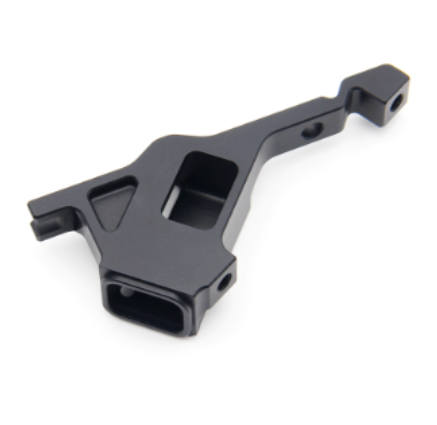Aluminum Bike Parts refers to bicycle accessories made of aluminum alloy as the main raw Material. It covers a wide range, including but not limited to bicycle frames, handlebars, rims, cranks, seat tubes, pedals, transmission housings, brake accessories, light brackets, etc. This type of accessories is widely used in the bicycle manufacturing industry due to the light weight and strength advantages of aluminum, especially in road bicycles, mountain bikes, folding bikes, racing bikes and some electric bicycles.

Material:
6061 aluminum alloy
The most common aluminum alloy material, with good processing performance, excellent weldability and medium strength, is suitable for manufacturing non-load-bearing but corrosion-resistant parts such as frames, handlebars, and seat tubes.
7075 aluminum alloy
High strength and strong wear resistance, often used to manufacture load-bearing parts such as cranks, hubs, and brake calipers. The strength of this material is close to that of Steel but the weight is greatly reduced.
Aluminum-magnesium alloy (such as AZ31)
It has an extremely high strength-to-weight ratio and strong seismic resistance, and is suitable for manufacturing parts with high impact resistance requirements, such as mountain bike parts.
Anodized aluminum
The surface is anodized and has excellent anti-oxidation and anti-scratch Capabilities. It is often used for exposed parts such as handlebars, pedals or transmission housings, providing color options while enhancing anti-corrosion performance.
Applications:
Vehicle structural components
Aluminum frames, front forks, rear forks, etc. are used to build the basic framework of the vehicle to ensure strength and lightness.
Power transmission system
Aluminum cranks, flywheels, sprocket covers and other components ensure good power output efficiency and light handling.
Steering and control components
Including handlebars, handlebar stems, and brake levers, made of aluminum alloy, can improve response speed and riding comfort.
Auxiliary and decorative accessories
Such as headlight brackets, water bottle cages, footrests, shelves, decorative parts, etc., these components take into account functionality and aesthetic appearance.
Features:
Lightweight
The density of aluminum alloy is about one-third of that of steel, which significantly reduces the weight of the vehicle and improves riding efficiency and handling convenience.
Excellent processability
Aluminum is easy to cut, mill, stamp and weld, suitable for manufacturing parts of various complex geometric shapes, and improves design flexibility.
High corrosion resistance
Aluminum can quickly form a dense oxide film in the air, effectively preventing corrosion, so it is suitable for long-term use in complex outdoor environments.
High structural strength
Especially high-strength aluminum alloys such as 7075, which perform well in load-bearing structures and provide stable mechanical support while controlling weight.
Beautiful appearance
After sandblasting, anodizing, electrophoresis and other treatments, the aluminum parts have a smooth surface and rich colors, which enhances the visual beauty of the whole vehicle.
Advantages:
Energy saving and environmental protection
Aluminum can be recycled repeatedly, which is in line with the current green manufacturing concept, with low production energy consumption and simple waste treatment.
Moderate cost
Compared with carbon fiber and Titanium alloy, bicycle aluminum accessories have a high cost-effectiveness, with both lightweight advantages and popular price advantages.
Wide range of applications
From entry-level bicycles to high-end racing bicycles, aluminum accessories have a wide range of coverage to meet different consumer levels and riding needs.
Easy maintenance
The surface of aluminum accessories is not easy to rust, and it is easy to clean and maintain, and it is not easy to accumulate dirt and damage.
High-precision manufacturing
Most aluminum accessories are manufactured using CNC processing technology, with high dimensional accuracy, small assembly gaps, and stable performance.
Why choose Aluminum Bike Parts:
Improve the control of the whole vehicle
Aluminum handlebars, cranks and other parts are light and responsive, which helps with controllability and flexibility during riding, especially for mountain and road riding.
Ensure strength and durability
The strength of aluminum alloy materials can meet various stress requirements during riding, and it is not easy to break and deform, which is a guarantee of structural safety.
Good cost performance
Compared with high-cost carbon fiber parts, aluminum alloy parts provide more balanced performance and price, suitable for most cycling enthusiasts.
Strong compatibility and rich adaptation
Aluminum parts have a variety of product models and are easy to adapt to various frames and components to meet personalized and customized needs.
Adapt to a variety of riding environments
Whether it is urban riding, mountain cross-country or long-distance travel, aluminum parts can provide reliable support and durability, with good shock and pressure resistance.
High-end brands use more
Most international mainstream bicycle brands still widely use aluminum alloy accessories in their mid-to-high-end product lines, which shows its comprehensive performance and industry recognition.
Convenient custom processing
Aluminum is easy to machine. Customers can customize special accessories of different sizes, colors, holes, etc. according to brand, structure, function and other requirements to meet the diverse needs of the market.
Beautiful design enhances the appearance of the whole vehicle
Surface-treated aluminum parts have good visual expression and can provide a variety of color options such as metal original color, black, electroplated silver, red, blue, etc., to enhance the visual impact and brand sense of the whole vehicle.





 English
English

